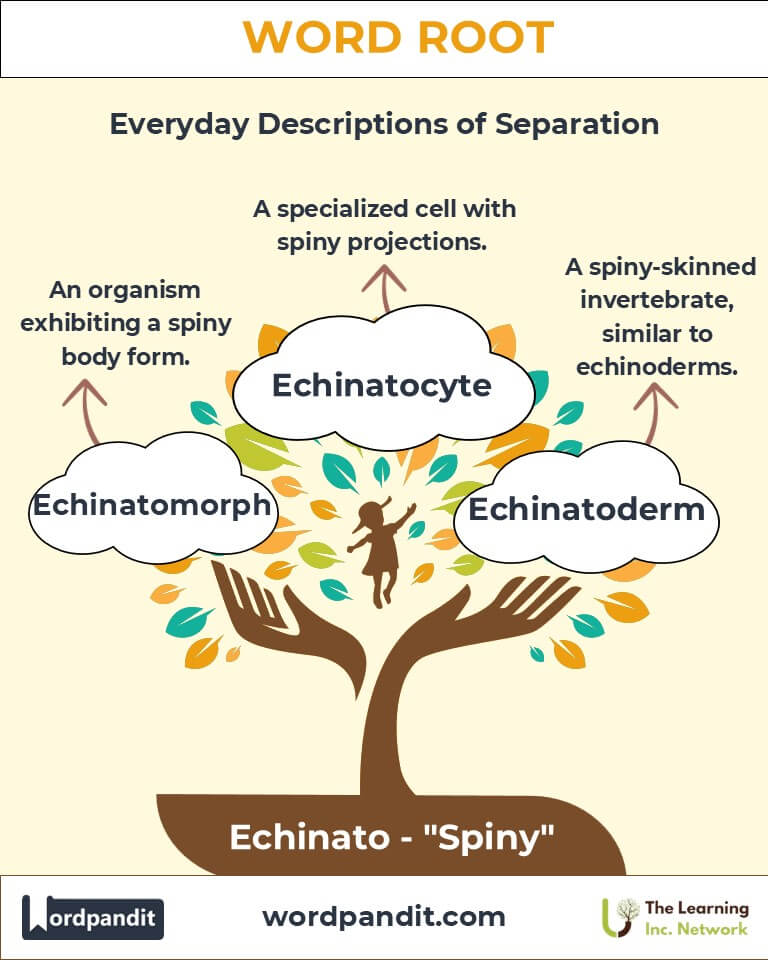Echinato: The Spiny Root in Science and Beyond
Discover the fascinating world of the word root "Echinato", derived from the Greek word for "spiny." This root forms the basis of scientific terms like "echinate" and "echinococcus", offering insights into biology, zoology, and medicine. Explore how this root connects concepts of spines, thorns, and protective structures in nature.

Table of Contents
- Introduction: The Essence of "Echinato"
- Etymology and Historical Journey
- Mnemonic: Unlocking the Power of "Echinato"
- Common "Echinato"-Related Terms
- "Echinato" Through Time
- "Echinato" in Specialized Fields
- Illustrative Story: "Echinato" in Action
- Cultural Significance of the "Echinato" Root
- The "Echinato" Family Tree
- FAQs About the"Echinato" Word Root
- Test Your Knowledge: "Echinato" Mastery Quiz
- Conclusion: The Living Legacy of"Echinato"
Introduction: The Essence of "Echinato"
What do hedgehogs, cacti, and sea urchins have in common? Their defining spiny features can be described using the root "Echinato", derived from the Greek word echinos, meaning "spiny" or "hedgehog." Pronounced eh-kih-nay-toh, this root appears in scientific terms to describe spiny or prickly structures, particularly in the natural world. From echinate leaves to echinoderms, "Echinato" conveys nature's ingenious adaptations for protection and survival.

Etymology and Historical Journey
The root "Echinato" traces back to the ancient Greek word echinos (hedgehog or sea urchin), symbolizing spiny or thorny characteristics. Early Greek naturalists used it to classify sea creatures like sea urchins, emphasizing their prickly exterior. Over time, "Echinato" evolved into a scientific descriptor, encompassing various spiny organisms and structures in biology, zoology, and medicine.
Mnemonic: Unlocking the Power of "Echinato"
To remember the essence of "Echinato," picture a hedgehog curled up in a spiny defense or a sea urchin on a rocky shore. These natural adaptations capture the protective and thorny essence of the root.
Mnemonic Device: "Echinato equals spiny defense, a natural hedge of protection."
Common "Echinato"-Related Terms
-
Echinate (eh-ki-nayt):
- Definition: Covered with spines or bristles.
- Example: "The echinate leaves of the plant deterred herbivores."
-
Echinoderm (eh-ki-no-derm):
- Definition: A marine invertebrate with a spiny exterior, such as sea urchins or starfish.
- Example: "Echinoderms like sea stars play vital roles in marine ecosystems."
-
Echinococcus (eh-ki-no-kok-uhs):
- Definition: A type of parasitic tapeworm known for its impact on human and animal health.
- Example: "The veterinarian diagnosed the dog with echinococcus infection."
"Echinato" Through Time
- Echinoid (Ancient Usage): Early naturalists used this term to describe sea urchins and similar creatures.
- Echinococcus (Modern Medicine): Its study expanded significantly in the 19th and 20th centuries, improving diagnosis and treatment of hydatid diseases caused by this spiny parasite.
"Echinato" in Specialized Fields
-
Biology:
- Echinate: Describes structures like spiny leaves, aiding plant defense.
- Example: "Cacti thrive in arid environments, using their echinate spines to deter predators."
-
Zoology:
- Echinoderms: Represent "Echinato's" role in marine ecosystems, balancing predator-prey dynamics.
- Example: "Sea urchins maintain coral reef health by controlling algae growth."
-
Medicine:
- Echinococcus: Highlights the parasitic implications of "Echinato." Understanding its lifecycle aids in combating zoonotic diseases.
- Example: "Vaccines and improved hygiene practices have reduced Echinococcus transmission globally."
Illustrative Story: "Echinato" in Action
On a bright summer day, young biologist Clara wandered into a forest teeming with life. She marveled at the echinate leaves of holly bushes and paused to sketch a hedgehog foraging for insects. Later, on a dive, she encountered echinoderms decorating the ocean floor. Her love for spiny creatures fueled her groundbreaking research on Echinococcus, leading to new treatments for rural communities affected by hydatid disease.
Cultural Significance of the "Echinato" Root
Spines symbolize defense and resilience in various cultures. In Greek mythology, sea urchins were seen as symbols of survival in harsh environments. Today, the "Echinato" root bridges ancient observations with modern science, emphasizing nature's balance between beauty and utility.

The "Echinato" Family Tree
-
Spina (Latin: "thorn, spine"):
- Spinach: A plant with spiny leaves in its wild form.
- Spinal: Relating to the backbone.
-
Thorn (Old English):
- Thorny: Difficult or full of challenges.
-
Derm (Greek: "skin"):
- Dermatology: The study of skin.
FAQs About the "Echinato" Word Root
Q: What does "Echinato" mean?
A: "Echinato" is derived from the Greek word echinos, meaning "spiny" or "thorny." It is used to describe surfaces, organisms, or structures that are covered with spines or prickles, often for protection or specialized functions.
Q: What are echinoderms?
A: Echinoderms are marine animals with spiny skins, such as sea urchins, starfish, and sand dollars. Their name comes from the root "Echinato," and they play vital roles in marine ecosystems, such as maintaining coral reef health and nutrient recycling.
Q: What is Echinococcus, and why is it important?
A: Echinococcus is a genus of parasitic tapeworms that cause hydatid disease in humans and animals. This disease can affect the liver and lungs and requires careful treatment or surgery. Understanding Echinococcus is crucial for combating zoonotic diseases transmitted between animals and humans.
Q: How do echinate structures benefit plants and animals?
A: Spiny structures like echinate leaves protect plants from herbivores by deterring them physically. In animals, spines provide defense against predators, as seen in sea urchins and porcupines, or aid in feeding and movement, as in echinoderms.
Test Your Knowledge: "Echinato" Mastery Quiz
1. What does "Echinato" mean?
2. Which of the following describes a spiny marine animal?
3. What is echinate used to describe?
4. What disease does Echinococcus cause?
5. How do echinate structures benefit plants?
Conclusion: The Living Legacy of "Echinato"
The "Echinato" root reflects nature’s adaptability, linking spiny features to survival and functionality. From scientific discovery to cultural symbolism, it highlights the intricate beauty of protective structures. Understanding "Echinato" fosters appreciation for life’s diversity, inspiring us to explore and protect the wonders of the natural world.












